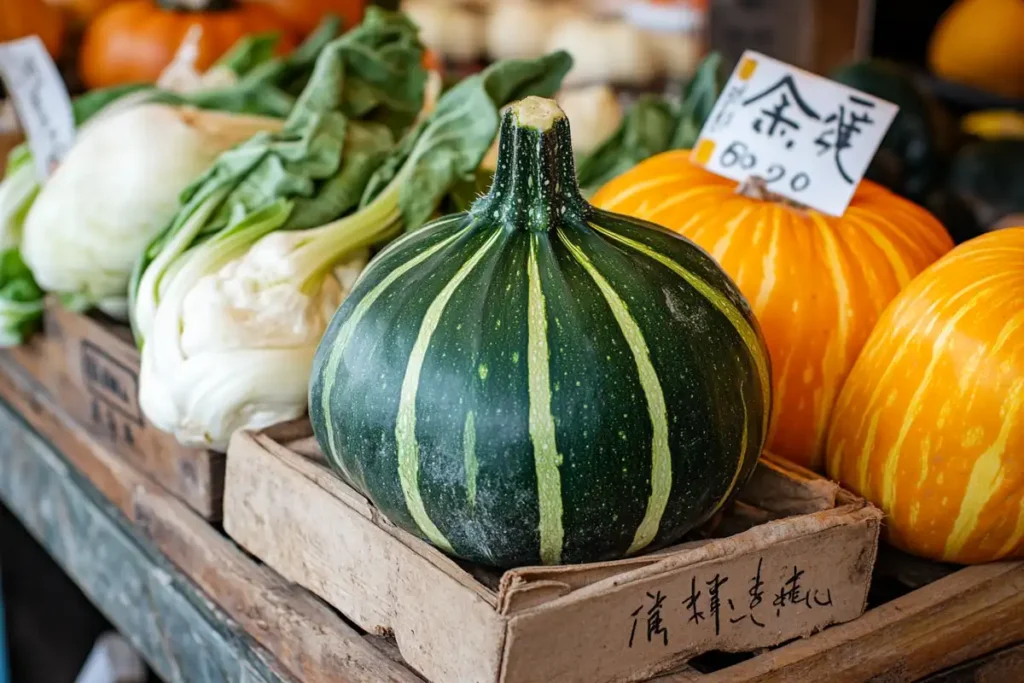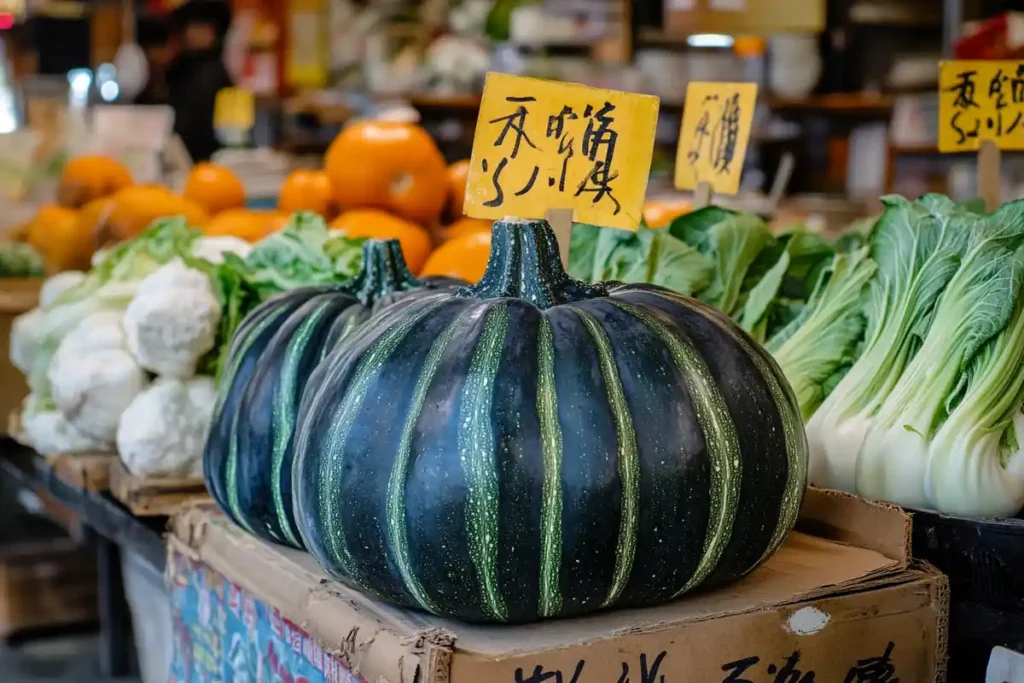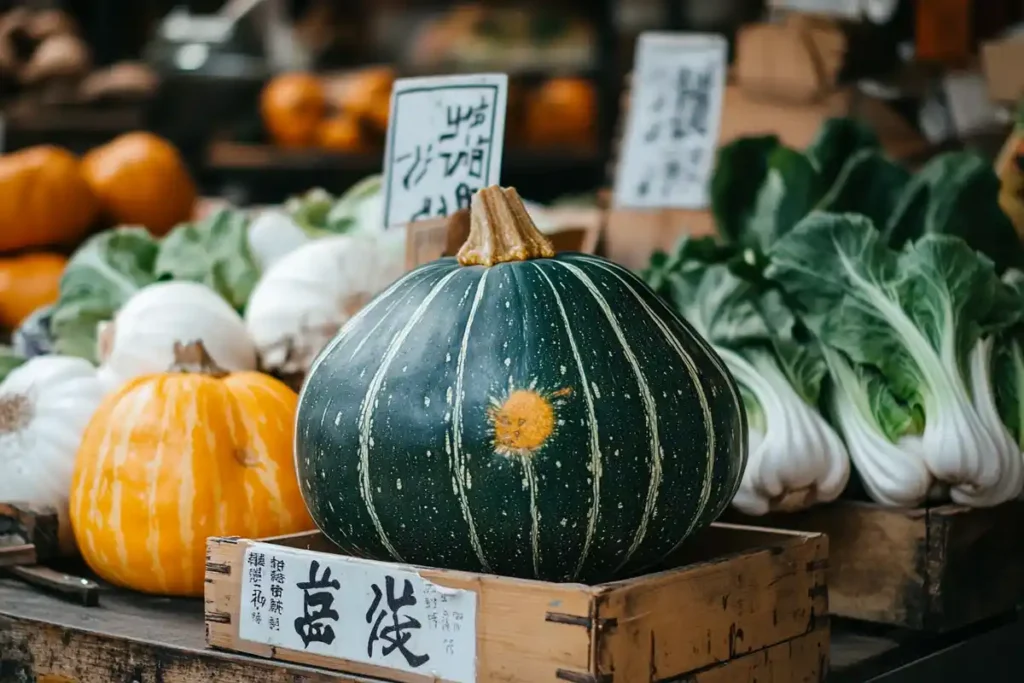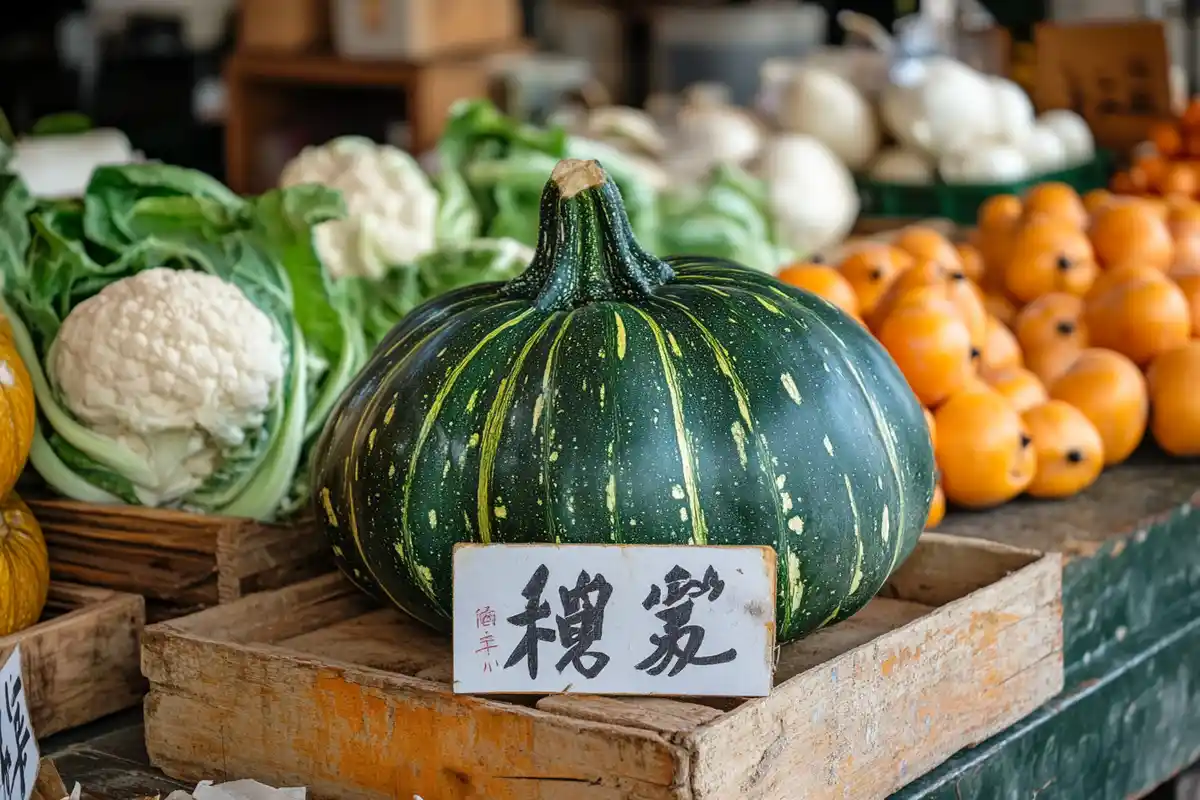Kabocha squash in Chinese cuisine has become a celebrated ingredient, known for its naturally sweet flavor, creamy texture, and versatility in both traditional and modern dishes. Commonly referred to as “南瓜” (nán guā) in Mandarin, this winter squash is not only delicious but also packed with essential nutrients like vitamins A and C, fiber, and antioxidants, making it a valuable addition to any meal.
From hearty stews in Northern China to light, steamed dishes in the South, kabocha squash adapts effortlessly to regional cooking styles. Its dense texture holds up well in soups, stir-fries, and even desserts, offering endless possibilities for creative culinary exploration. Whether you enjoy it in a classic stir-fry with garlic and ginger or a contemporary squash dumpling, kabocha brings both nutrition and flavor to the table.
This article delves into the cultural significance, preparation techniques, and health benefits of kabocha squash, showcasing how it enhances a variety of Chinese recipes. Get ready to discover why this vibrant squash is a must-have ingredient in Chinese cuisine.
The Role of Kabocha Squash in Chinese Cuisine
Kabocha squash, commonly known as Japanese pumpkin, has found a prominent place in Chinese kitchens for its versatility, sweetness, and rich texture. With its ability to blend seamlessly into a variety of dishes, this nutrient-packed squash has become a staple in both traditional and modern Chinese recipes.
What is Kabocha Squash in Chinese Cuisine?
In Mandarin, kabocha squash is referred to as “南瓜” (nán guā), translating to pumpkin or squash. The Cantonese pronunciation is “naam4 gwaa1,” but the characters remain the same. While the squash is originally Japanese, its adaptability has made it a favorite ingredient in Chinese cooking, appearing in everything from soups to stir-fries.
- Traditional Use: Kabocha is a popular choice in Chinese cuisine for its natural sweetness, which enhances both savory and sweet dishes.
- Regional Variations: Northern China often features kabocha in hearty stews to combat the cold, while Southern Chinese recipes focus on light, steamed dishes.
For more insights into how kabocha fits into regional Chinese cuisine, explore Chinese Squash Recipes: Kabocha Vegan.
Why is Kabocha Squash Popular in Chinese Cooking?
Kabocha squash has several qualities that make it a preferred ingredient in Chinese kitchens:
- Flavor: Its naturally sweet taste complements a wide range of Chinese condiments, such as soy sauce, sesame oil, and oyster sauce.
- Texture: The dense, creamy flesh holds up well to various cooking methods, from steaming to braising.
- Nutrition: Packed with vitamins A and C, fiber, and antioxidants, kabocha squash adds nutritional value to any dish.
The nutritional benefits of kabocha squash make it a great choice for those seeking a healthy ingredient. For preparation tips, visit Peel Kabocha Squash Before Cooking.
How to Prepare Kabocha Squash for Chinese Dishes
Preparing kabocha squash involves a few key steps to ensure it’s ready for your favorite recipes.
Selecting and Storing
- Choosing the Best Squash: Look for a squash with firm, deep green skin and a weighty feel.
- Storage Tips: Whole squash can be stored in a cool, dry place for up to a month. Once cut, wrap tightly and refrigerate for use within a week.
Peeling Kabocha Squash in Chinese and Cutting
Peeling kabocha squash is often recommended for soups, purees, and congee, where a smooth texture is desired. Learn more about effective peeling techniques at Peeling Apricots Before Cooking.
- Step 1: Wash thoroughly to remove any dirt.
- Step 2: Soften the skin by microwaving or steaming for a few minutes.
- Step 3: Use a sharp knife or vegetable peeler to remove the tough skin.
Popular Cooking Methods for Kabocha Squash in Chinese Cuisine
1. Steaming
Steaming is a popular method in Southern China. The process retains the squash’s nutrients and enhances its natural sweetness.
- Peel and cube the squash for even steaming.
- Serve as a side dish or mash it for dumpling fillings.
2. Stir-Frying
Thin slices of kabocha squash are stir-fried with aromatics like garlic and ginger, often paired with soy sauce for a quick and flavorful dish.
- Add proteins such as chicken or tofu for a complete meal.
- For complementary recipes, see Garlic Parmesan Chicken and Potatoes.
3. Soups and Congee
Kabocha squash adds creaminess and sweetness to broths and rice porridge. It pairs well with ingredients like dried scallops, ginger, and chicken stock for a comforting dish.
Flavor Pairings and Regional Specialties
The versatility of kabocha squash allows it to pair with a wide variety of ingredients:
- Aromatics: Garlic, ginger, and scallions enhance its flavor.
- Seasonings: Soy sauce, oyster sauce, and sesame oil complement its sweetness.
- Spices: Five-spice powder and star anise add depth to soups and braised dishes.
For regional twists, Northern recipes often braise kabocha with meat, while Southern dishes highlight its natural flavor through steaming or light stir-frying. Learn more about flavor pairings at Flavors That Complement Apricots.
Conclusion
The adaptability of kabocha squash cuisine makes it a valuable ingredient in a wide range of dishes. From its nutritional benefits to its ability to enhance both savory and sweet recipes, kabocha squash is a must-have for any kitchen. With proper preparation and the right cooking techniques, it can elevate traditional Chinese dishes to new levels of flavor and texture.
Recipes and Techniques for Cooking Kabocha Squash in Chinese Cuisine

Kabocha squash in Chinese cooking is beloved for its sweet flavor and creamy texture, making it a versatile ingredient in both traditional and modern dishes. Whether you’re creating stir-fries, soups, or steamed delights, kabocha squash adds depth and nutrition to your meals. This section explores detailed recipes and techniques to prepare and cook kabocha squash, showcasing its adaptability in Chinese cuisine.
Popular Chinese Recipes Featuring Kabocha Squash
1. Stir-Fried Kabocha Squash with Garlic and Ginger
This quick and easy recipe highlights the natural sweetness of kabocha squash while infusing it with savory garlic and ginger.
- Ingredients: Thinly sliced kabocha squash, minced garlic, grated ginger, soy sauce, and sesame oil.
- Preparation:
- Heat oil in a wok.
- Add garlic and ginger, stir until aromatic.
- Toss in sliced kabocha squash and stir-fry until tender.
- Serving Suggestion: Pair with steamed rice for a simple yet flavorful meal.
Learn more about incorporating complementary vegetables by exploring Chinese Squash Recipes: Kabocha Vegan.
2. Kabocha Squash Congee
Congee, or rice porridge, is a comforting dish, and the addition of kabocha squash brings a creamy texture and subtle sweetness.
- Ingredients: Cooked rice, diced kabocha squash, ginger slices, and chicken or vegetable stock.
- Preparation:
- Simmer diced squash in stock until soft.
- Add cooked rice and stir until creamy.
- Top with scallions and sesame oil before serving.
For more tips on preparing ingredients for congee, visit Peeling Apricots Before Cooking.
3. Braised Kabocha Squash in Chinese in Soy Sauce
A savory dish, this recipe combines kabocha squash with a flavorful soy-based braising liquid, perfect for serving with steamed rice.
- Ingredients: Cubed kabocha squash, soy sauce, oyster sauce, sugar, garlic, and star anise.
- Preparation:
- Sauté garlic until fragrant, then add cubed squash.
- Pour in soy sauce, oyster sauce, and a bit of water.
- Add star anise and simmer until the squash is tender and the sauce thickens.
This dish pairs wonderfully with simple sides like Garlic Parmesan Chicken and Potatoes.
Techniques for Cooking Kabocha Squash in Chinese Cuisine

Steaming
Steaming preserves the squash’s natural sweetness and nutrients, making it a popular method in Southern Chinese cooking.
- Peel and cube the squash for even cooking.
- Place in a steamer basket over boiling water and steam for 10–15 minutes.
- Mash steamed squash as a filling for buns or dumplings.
Stir-Frying
The quick-cooking method of stir-frying locks in flavor and ensures a tender texture for kabocha squash.
- Slice the squash thinly for faster cooking.
- Use high heat and aromatics like garlic, ginger, and scallions to bring out its best qualities.
Braising
Braising involves cooking squash slowly in a flavorful liquid, which allows it to absorb spices and seasonings.
- Combine soy sauce, oyster sauce, sugar, and star anise for a rich braising liquid.
- Simmer the squash until tender, creating a dish perfect for colder months.
For tips on enhancing braised dishes, explore Flavors That Complement Apricots.
Flavor Pairings for Kabocha Squash in Chinese Dishes
Kabocha squash’s sweet and nutty flavor pairs well with a variety of ingredients common in Chinese cuisine:
- Aromatics: Garlic, ginger, and scallions enhance its natural sweetness.
- Seasonings: Soy sauce, sesame oil, and oyster sauce add depth and umami.
- Spices: Star anise, Sichuan peppercorns, and five-spice powder complement its rich flavor.
Suggested Pairing Dishes
- Serve braised kabocha alongside stir-fried greens for a balanced meal.
- Pair congee with pickled vegetables for added texture and flavor contrast.
Health Benefits and Modern Adaptations of Kabocha Squash in Chinese Cuisine

Kabocha squash in Chinese cooking is not only valued for its sweet flavor and creamy texture but also for its numerous health benefits. As Chinese cuisine evolves to incorporate modern techniques and influences, kabocha squash continues to shine as a versatile ingredient in both traditional and innovative dishes.
The Health Benefits of Kabocha Squash in Chinese Diets
Kabocha squash is a nutrient-rich food that offers several health advantages, making it a popular choice in Chinese kitchens:
High in Essential Vitamins in Kabocha Squash in Chinese
- Vitamin A: Kabocha squash is packed with beta-carotene, which supports eye health, boosts immunity, and promotes healthy skin.
- Vitamin C: This antioxidant strengthens the immune system and improves skin health.
Rich in Fiber
- Fiber promotes healthy digestion and keeps you feeling full longer, making kabocha an excellent choice for balanced meals.
Low in Calories
- Despite its creamy texture, kabocha squash is low in calories, making it ideal for weight-conscious diets.
For tips on preparing kabocha for health-focused meals, visit Peel Kabocha Squash Before Cooking.
Modern Adaptations of Kabocha Squash in Chinese Cuisine
As global culinary trends influence Chinese cooking, kabocha squash is being adapted into a variety of modern dishes that blend tradition with innovation.
Fusion Dishes
Kabocha squash is increasingly used in fusion recipes that combine Chinese flavors with international influences.
- Kabocha Squash Dumplings:
- Mashed kabocha squash serves as a filling for dumplings, paired with ginger and scallions for a sweet-savory balance.
- These dumplings can be steamed or pan-fried, offering a creative twist on a classic dish.
- Squash Baozi (Steamed Buns):
- Incorporating kabocha squash puree into bao dough or as a filling enhances flavor and visual appeal.
For more innovative ideas, explore Chinese Squash Recipes: Kabocha Vegan.
Contemporary Soups
Modern interpretations of traditional soups highlight kabocha squash as a key ingredient:
- Creamy Kabocha Soup: Blended squash, coconut milk, and a hint of ginger create a smooth, fragrant soup.
- Spicy Sichuan-Style Soup: Adding Sichuan peppercorns and chili oil transforms kabocha soup into a bold, spicy dish.
For complementary soup recipes, check out Flavors That Complement Apricots.
Incorporating Kabocha Squash into Everyday Chinese Meals
Breakfast
Kabocha squash can be featured in quick and nutritious breakfast options:
- Steamed Kabocha Slices: A simple, lightly seasoned dish that pairs well with congee or soy milk.
- Kabocha Pancakes: Mixing mashed squash with flour and spices creates a healthy twist on traditional Chinese pancakes.
Lunch and Dinner
- Stir-Fried Kabocha: Quick to prepare and packed with flavor, stir-fried squash with garlic and soy sauce is a staple for busy families.
- Kabocha Hot Pot: Add sliced squash to a bubbling pot of broth alongside meats and vegetables for a comforting meal.
Desserts
Kabocha squash’s natural sweetness makes it ideal for desserts:
- Sweet Squash Soup: Cooked with rock sugar and tapioca pearls, this dessert is a light and refreshing option.
- Kabocha Mooncakes: Using squash puree in mooncake fillings offers a modern twist on the traditional treat.
Frequently Asked Questions about Kabocha Squash in Chinese
Is Kabocha Squash Common in Chinese Cuisine?
Yes, kabocha squash is widely used in Chinese cooking, especially in soups, stir-fries, and desserts. Its versatility and sweetness make it a popular ingredient.
What Are the Health Benefits of Kabocha Squash?
Kabocha is rich in vitamins A and C, fiber, and antioxidants, supporting digestion, immunity, and overall health.
How Does Kabocha Compare to Other Squash?
Kabocha squash is sweeter and denser than butternut squash, making it ideal for recipes requiring minimal seasoning.
Can Kabocha Squash Be Used in Modern Chinese Dishes?
Absolutely! Its adaptability makes it suitable for fusion dishes, creative desserts, and contemporary twists on traditional recipes.
For more on incorporating squash into modern dishes, visit Garlic Parmesan Chicken and Potatoes.
Kabocha Squash in Chinese: Conclusion
The versatility of kabocha squash in Chinese cuisine continues to inspire both traditional and modern cooks. Its health benefits, sweet flavor, and ability to adapt to various cooking methods make it a treasured ingredient. By experimenting with new recipes and techniques, you can enjoy the full potential of kabocha squash in your culinary creations.

